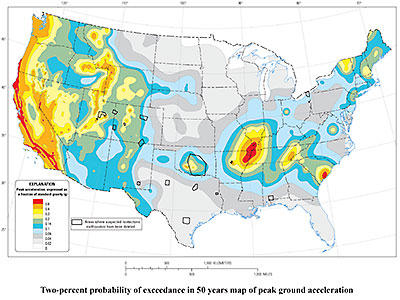
Nevada has a similar chance as L.A. or the Bay Area for an earthquake of more than 0.8 g every 50 years, according to scientists. Click on map to enlarge.
Colleges in the Silver State, including Truckee Meadows Community College, are taking part in the Great Nevada ShakeOut drill on Thursday, October 15.
At 10:15 a.m., students, faculty and staff will practice “Drop, Cover, and Hold On” to prepare for large earthquakes that could strike in the region. The Nevada Seismological Lab at the University of Nevada, Reno is sponsoring the statewide drill.
“Though many people do not know, Nevada has as much seismic hazard as the Bay Area and L.A., but we have had an abnormal lack of large events in recent times,” said Annie Kell, PhD, Education and Outreach Seismologist, Nevada Seismological Laboratory at UNR. “Because of this, the general population is not well educated on what to do during an event or that we have an earthquake risk at all.”
She said that a good introductory video produced by the Federal Emergency Management Agency (FEMA) is now posted on YouTube to educate people in what to do during a quake.
TMCC’s Public Safety and Police Department have registered the College in the exercise scheduled for Oct. 15.
As part of the drill, faculty, staff and students will receive:
- An emergency text message from the TMCC Alert System
- An emergency TMCC phone alert may follow
Is an Earthquake in Reno Likely?
“So this means that Reno, just like the Bay Area, has a 2% chance of a large event (exceeding 80% the force of gravity or 0.8 g) every 50 years,” Kell wrote in an email.
She explains that Reno-Sparks has an extended shake area whether or not a structure is directly over a fault line.
“The Truckee Meadows is an approximately one-kilometer-deep sedimentary basin where seismic energy will be focused no matter where it initiates,” she writes. “If you think about a bowl of jello, it shakes and the waves resonate throughout; that is a similar analogy to seismic shaking in a basin. The energy becomes trapped within the basin, resulting in longer periods of shaking.”
Urban Legend – The "Triangle of Life"
In recent years, a theory known as the “Triangle of Life” has been circulated in social media. The thought is that if a person huddles down close to an object, such as beside a bed or a car, that structural elements will fall on that object and angle down to the ground, creating a safe triangle of space.
“This is the number one most persistent rumor that seismologists battle in educating earthquake safety,” Kell said. “The proper reaction to earthquake shaking is to get to the ground, cover in any way you can, with arms or under a desk, and hold on in order to prevent yourself from being thrown around.”
She said the triangle concept is not supported by scientists or world safety organizations such as the American Red Cross or UNICEF.
“That notion is an ‘urban legend’ that is not substantiated by real data in rescue situations from real earthquakes,” she writes. “The likelihood that one can predict the way that a building will fall in a manner that will allow the non-crushed zone is very, very low.”
Kell added that most injuries are not caused by structural collapse, but by objects and non-structural elements.
“By getting under a sturdy object, you will likely be protected from any falling object, whether due to building collapse or objects, in a more reliable way than having nothing above your head,” she said.
What Does a Strong Quake Feel Like?
Dr. Kell experienced a magnitude 7 earthquake during a vacation in New Zealand in 2010. A magnitude 5 foreshock woke her six seconds before the main quake’s intense jolting.
“It would have been physically impossible to walk across the floor,” she writes. “The bed was moved 10 feet across the room with us both on it. The shelves, mirrors, windows all broke. The floor was completely covered in glass. I was able to reach our suitcase from the bed to get shoes so we did not have to go barefoot to get out of the building.”
If you are awakened by a quake, experts advise to stay in bed, protect yourself where you are and keep shoes nearby.
“Throughout the day, there were dozens of aftershocks and the city was in shambles,” she writes. “New Zealand has a very strong earthquake education program, so in general, the population knows what to do. No one was killed in that event. The same size event in Haiti killed 300,000 people. The reason for that is building standards, and proper earthquake response.”
The experience changed her life. Kell now focuses her career on educating people about how to respond to quakes.
For more information about TMCC’s participation in the Great Nevada ShakeOut earthquake drill, please call the Public Safety and Police Department at 775-674-7900.






